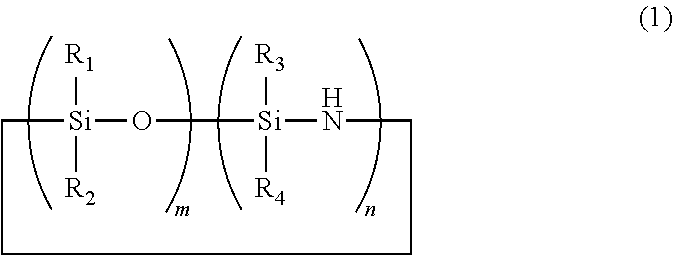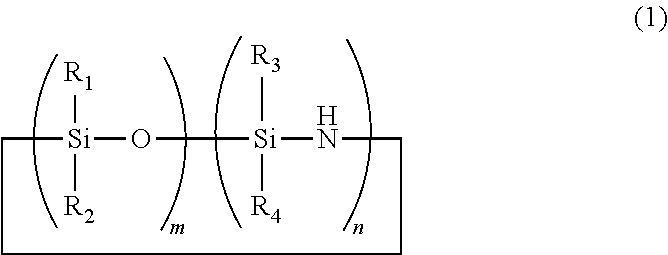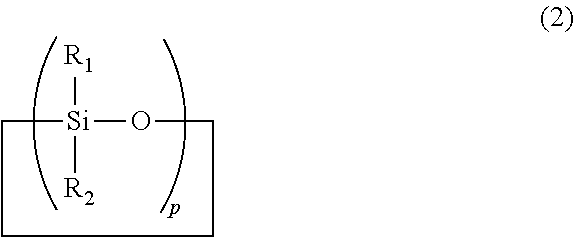Cyclic polyorganosiloxanesilazane and method of producing same
a technology of polyorganosiloxanesilazane and cyclic polyorganosiloxanesilazane, which is applied in the direction of organic compounds, chemistry apparatus and processes, and group 4/14 element organic compounds, can solve the problems of unsatisfactory reactivity of these compounds as silylating agents, and achieve the effect of satisfying reactivity
- Summary
- Abstract
- Description
- Claims
- Application Information
AI Technical Summary
Benefits of technology
Problems solved by technology
Method used
Image
Examples
example 1
Synthesis of Cyclic Polyorganosiloxanesilazane (1)
[0047]A sealed vessel (1.5 L) was charged with hexamethylcyclotrisiloxane (542.03 g, 2.44 mol, 1.0 equivalent), dimethyldichlorosilane (404.13 g, 2.69 mol, 1.1 equivalents) and concentrated sulfuric acid (47.31 g, 0.37 mol, 5 mass %), and the resulting mixture was stirred under a nitrogen atmosphere at room temperature for 12 hours. Subsequently, the thus obtained crude product was transferred to a 5 L three-neck separable flask and dissolved in heptane (2 L). The resulting solution was cooled to 5° C. using an ice bath, and excess ammonia gas was then passed through the solution for a period of 8 hours to effect a reaction. Following completion of the reaction, the reaction liquid was stirred for 2 hours at 60° C. to volatilize the excess ammonia gas, and the reaction liquid was then cooled to room temperature and filtered to remove by-product salts. Subsequently, the solvent and any neutral by-products such as ammonium salts were r...
example 2
Synthesis of Cyclic Polyorganosiloxanesilazane (2)
[0049]A 1 L three-neck separable flask was charged with hexamethylcyclotrisiloxane (222.44 g, 1.0 mol, 1.0 equivalent), dimethyldichlorosilane (135.62 g, 1.05 mol, 1.05 equivalents) and hexamethylphosphoric triamide (174 μL, 0.001 mol), and the resulting mixture was stirred under a nitrogen atmosphere at room temperature for 3 hours. Subsequently, the thus obtained crude product was dissolved in toluene (716 g), the resulting solution was cooled to 5° C. using an ice bath, and excess ammonia gas was passed through the solution for a period of 8 hours to effect a reaction. Following completion of the reaction, the reaction solution was stirred for 2 hours at 60° C. to volatilize the excess ammonia gas, and the reaction solution was then cooled to room temperature and filtered to remove by-product salts. Subsequently, the solvent and any neutral by-products such as ammonium salts were removed from the filtrate by heating under reduced ...
example 3
Synthesis of Cyclic Polyorganosiloxanesilazane (3)
[0050]A 5 L three-neck separable flask was charged with tris(3,3,3-trifluoropropyl)trimethylcyclotrisiloxane (777.76 g, 1.66 mol, 1.0 equivalent), dimethyldichlorosilane (236.59 g, 1.83 mol, 1.1 equivalents) and 1,3-dimethyl-3,4,5,6-tetrahydro-2(1H)-pyrimidinone (2.15 g, 0.017 mol, 0.01 equivalents), and the resulting mixture was stirred under a nitrogen atmosphere at room temperature for 12 hours. Subsequently, the thus obtained crude product was dissolved in toluene (2 kg), the resulting solution was cooled to 5° C. using an ice bath, and excess ammonia gas was passed through the solution for a period of 6 hours to effect a reaction. Following completion of the reaction, the reaction solution was stirred for 2 hours at 60° C. to volatilize the excess ammonia gas, and the reaction solution was then cooled to room temperature and filtered to remove by-product salts. Subsequently, the solvent and any neutral by-products such as ammoni...
PUM
| Property | Measurement | Unit |
|---|---|---|
| temperature | aaaaa | aaaaa |
| reaction time | aaaaa | aaaaa |
| time | aaaaa | aaaaa |
Abstract
Description
Claims
Application Information
 Login to View More
Login to View More - R&D
- Intellectual Property
- Life Sciences
- Materials
- Tech Scout
- Unparalleled Data Quality
- Higher Quality Content
- 60% Fewer Hallucinations
Browse by: Latest US Patents, China's latest patents, Technical Efficacy Thesaurus, Application Domain, Technology Topic, Popular Technical Reports.
© 2025 PatSnap. All rights reserved.Legal|Privacy policy|Modern Slavery Act Transparency Statement|Sitemap|About US| Contact US: help@patsnap.com



